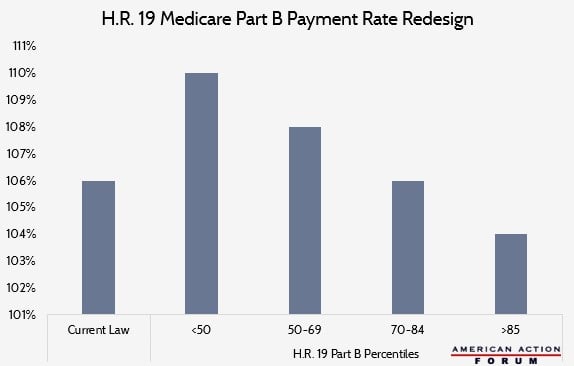Weekly Checkup
December 13, 2019
Two Lost Opportunities for Bipartisan Legislating
As we enter the last week of the 2019 legislative calendar, hope is fading that Congress will enact major drug policy or surprise medical billing reforms. The sad irony is that we’ve likely never been closer to a deal on either than we are now.
Looking back over the last year, the shifting positions on federal policy around pharmaceuticals means that there are many substantive policy ideas on which a broad cross section of Republicans and Democrats agree. Yesterday, however, the House passed H.R. 3, Speaker Pelosi’s “Elijah E. Cummings Lower Drug Costs Now Act,” and voted down H.R. 19, “the Lower Costs, More Cures Act,” a Republican-introduced alternative, largely along partisan lines. The result is that any hope for action on drug prices in the first session of the 116th Congress has probably died.
All through the summer and fall, the Speaker and the White House were doing a dance around whether they would or wouldn’t cut a deal. That door seems firmly shut now, as the Speaker continues to cave to progressive policy demands and the White House has issued a Statement of Administration Policy on Monday, promising a veto if H.R. 3 passes the Senate. Of course, it won’t come to that. Senate Majority Leader McConnell was almost certainly never going to bring H.R. 3 to the Senate floor without extreme pressure from President Trump himself, and maybe not even then.
At the same time, Senators Grassley and Wyden have a bipartisan package of drug price reforms that is floundering in the Senate, S. 2543, the “Prescription Drug Pricing Reduction Act of 2019.” The problem with S. 2543 is that it lacks broad support among Senate Republicans, mostly due to penalties for drug manufacturers who raise their prices faster than inflation. Senate Democrats object to removing the penalties, while many Senate Republicans—including a majority of Finance Committee Republicans—oppose the bill if they remain.
Still, there is a lot of overlap between H.R. 3 and S. 2543, so the groundwork for a compromise package has already been laid—which is where H.R. 19 comes in. When they rolled out the proposal earlier this week, Republicans touted it as a bipartisan alternative with no poison pills for Republicans or Democrats. You’ll be forgiven for disbelieving that claim initially, but AAF’s Tara O’Neill Hayes has compared all three bills (as well as the pharmaceutical policy provisions in the Senate Health, Education, Labor, and Pensions (HELP) Committee’s S. 1895, the “Lower Health Care Costs Act,” which has bipartisan support) and finds the GOP’s claims largely true. H.R. 19 doesn’t include plenty of progressive priorities, but it also doesn’t ask Democrats to vote for any policies they strongly oppose. Similarly, Republicans have been evolving on drug pricing issues for a while, and there isn’t anything in this bill that would give the majority of them much heartburn. Nonetheless, only a handful of House Democrats voted for H.R. 19.
As for surprise medical billing, reforms looked dead in the water a few weeks ago, but when the Senate HELP and House Energy and Commerce Committees announced a bipartisan, bicameral deal earlier this week, action seemed possible—even likely—before the year’s end. Then the Democratic and Republican leaders on the House Ways and Means Committee released an alternative proposal and called for discussions to continue into next year, potentially derailing action in 2019.
On both fronts, it’s a disappointing end to a year that held at least some promise for bipartisan health legislation. Of course, it’s not a total loss. S.1379, the “Pandemic and All-Hazards Preparedness and Advancing Innovation Act of 2019,” was enacted back in June, so there’s that.
Chart Review
Andrew Strohman, Health Care Data Analyst
AAF’s Tara O’Neill Hayes recently compared four different drug pricing bills introduced to Congress, including H.R. 19, the Lower Costs, More Cures Act. Among other things, H.R. 19 attempts to lower drug costs through reform of the Medicare Part B payment methodology for physician-administered drugs. Currently, the payment rate for such drugs is 106 percent of the Average Sales Price (ASP), defined as the volume-weighted average sales price after all rebates, discounts, and price concessions. As seen in the chart, H.R. 19 would amend this payment rate by introducing variability based on the drug’s price per beneficiary. For drugs that fall under the 50th percentile, the payment rate is increased to 110 percent of ASP. This payment rate decreases as the price’s percentile rises, with those drugs in the 85th percentile reimbursed at 104 percent of ASP. If enacted, this reform could potentially incentivize providers to utilize cheaper drugs to curb patient and government costs.
Data obtained from the Lower Costs, More Cures Act of 2019
From Team Health
Testimony Regarding “Proposals to Achieve Universal Health Care Coverage” – AAF President Douglas Holtz-Eakin
The two broad approaches to expanding health insurance coverage — a Medicare-for-All single payer system, and a more incremental approach — both have serious flaws.
Comparing the Recent Drug-Pricing Reform Proposals – Deputy Director of Health Care Policy Tara O’Neill Hayes
Four recent bills seeking to reform drug pricing overlap on a significant number of provisions, although there are notable differences, too.
Worth a Look
New York Times: South Carolina Is the 10th State to Impose Medicaid Work Requirements
Modern Healthcare: Chart reviews boost Medicare Advantage payments by $6.7 billion, OIG finds











